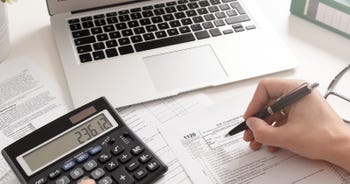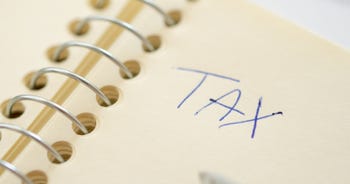End of Year Tax: How to Fully Prepare for the Financial Year End
The end of the financial year is a big event in the life of any business. But more often than not, it’s perceived as a time of late nights, pouring coffees as you pour over the numbers, trying to handle the stress of getting your finances sorted before the deadline.
The thing is: sorting your year-end tax doesn’t have to be this stressful. With our handy tips, you can start preparing for the end of the financial year without having to compromise on your mental health — and keeping your business accounts nice and healthy too.
What is the financial year end?
The financial year (also known as the ‘tax’ year) is the period in which new government taxation goes live. It starts in April and runs until the following March, when the new budget is announced.
Towards the end of the financial year, companies need to prepare a final financial statement, ready for an external audit. Preparing this statement is known as ‘closing’. Businesses will store this statement within their official records, and they’ll submit copies to government authorities like HMRC and Companies House.

What happens during the financial year-end?
During year-end closing, your accountants will check your financial records for any discrepancies between your income and your outgoings: accounts payable and accounts receivable. If they find any, you’ll need to rectify the issue by reaching out to employees for any missing information.
The legal consequences of an inaccurate balance sheet can be severe — spanning everything from fines to appearances in court — so it’s imperative companies afford themselves enough time to dot the i’s and cross the t’s.
When is the deadline for submitting year-end accounts?
The deadline for submitting your accounts is usually within six months of the financial year end. Here are the deadlines you should prepare for.
| Requirement | Deadline |
| Companies House requirements | |
| To file your company’s first accounts with Companies House | 21 months after the date you registered with Companies House |
| To file annual accounts with Companies House | 9 months after your company’s financial year ends |
| HMRC requirements | |
| Pay Corporation Tax | 9 months and 1 day after your accounting period ends |
| File a Company Tax Return | 12 months after your accounting period ends |
Here are the deadlines for the most recent financial year:
| Self Assessment | Deadline |
| Register for Self Assessment if you’re self-employed or a sole trader, not self-employed, or registering a partner or partnership | 5 October 2022 |
| Paper tax returns | Midnight 31 October 2022 |
| Online tax returns | Midnight 31 January 2023 |
| Pay the tax you owe | Midnight 31 January 2023 |
What happens if I miss the deadline?
You’ll have to pay a fine as penalty if you’re late submitting your accounts. Leaving it late could land you in hot water and thousands of pounds worse off, especially because you’ll pay interest on late payments.
HRMC fines
| Lateness | Fine Amount |
| 1 day | £100 |
| 3 months | Another £100 |
| 6 months | HMRC will estimate your Corporation Tax bill and add a penalty of 10% the unpaid tax |
| 12 months | Another 10% of any unpaid tax |
If your tax return is late three times in a row, the £100 penalties are increased to £500 each. The fines are different for Companies House, where you’ll also need to submit your accounts.
Companies House fines
| Lateness | Fine Amount |
| Up to a month late | £150 |
| 1 to 3 months late | £375 |
| 3 to 6 months late | £750 |
| Over 6 months late | £1,500 |
| If you file late two years in a row | Penalties double |
If you don’t send your accounts or Confirmation Statement to Companies House when it’s due, you can even have your company struck off from the register.
What can make closing a year-end difficult?
Completing your end-of-year accounts can be surprisingly time-consuming. Estimates suggest it takes a typical accounting team as long as 25 working days to wrap everything up, so it’s important not to leave it late.
There are a few common hurdles that will make things even more difficult:
1. Missing invoices and receipts
Ever forgotten to ask for a receipt on your train ticket on the way to see a client? So have millions of others — and it creates plenty of problems for accountants at the end of the year.
Every business expense needs to be accounted for with evidence. Historically, that’s been in the form of a paper receipt, which is notoriously easy to lose. Lost receipts can cause significant gaps in the books.
2. Chasing employees
Even when the receipt is safely stored, finance teams can sometimes find themselves having to chase distracted employees for them, upping the pressure as the deadline looms.
Businesses need a formalised process for submitting payments and debts to the finance team within the same month they’re incurred. That way, you’re only chasing last month’s transactions, rather than receipts for the entire year.
3. Manual data entry
Some things are best done ‘the old fashioned way’ — but closing your accounts shouldn’t be one of them. Still, it’s surprisingly common for business owners and accountants to spend precious time manually entering data into spreadsheets, which is both hugely time-consuming and prone to human error.
Today, every business should invest in some form of accounting software. That way, you can speed up closing while minimising errors so you can focus on what really matters: doing business.
Filing your year-end accounts: checklist
What to file with HMRC
- Company Tax Return (CT600) — Your Company Tax Return states your business’s income, deducting expenses and tax allowances. What’s left is used to calculate your Corporation Tax.
- Income statement — Details your total profits or losses for the tax period.
- Footnotes — Discloses any transactions made between your company and its directors; things like loans and monetary advances.
- Statement of Financial Position (formerly known as a Balance Sheet) — The overall value of your business based on its assets, liabilities (debts), capital, and reserves.
What to file with Companies House
- Footnotes
- Statement of Financial Position
You should note that the documents you submit to Companies House will be published on its website and can be viewed by anyone.
Other documents you need to file
- VAT Returns — If you're VAT registered, you'll probably have a VAT return due around the same time as your year-end accounts. VAT return is separate from your end-of-year tax filing, but it usually coincides with it.
- Confirmation statement — Once a year, directors of limited companies need to confirm the accuracy of company information with Companies House -- things like who sits on the board, staff headcount, and your current business premises. Failure to do so can land you in court and being personally fined; you could even be struck off the Companies House register. The due date is normally a year after your incorporation or the date you last completed a Confirmation Statement
What should I do to get my company ready for end-of-year closing?
1. Prepare a closing schedule
If you want to avoid a ‘crunch’ at the year-end that puts undue pressure on staff and leads to errors in your accounting, you should prepare a schedule for closing your accounts in advance.
Unless you have a truly industry-leading team, it’s best to assign at least two months for a full closing schedule. This should include reporting and data processing deadlines at intervals leading up to the year-end closing date.
A closing schedule might include deadlines for tasks like:
- Backing up key files
- Closing the payroll
- Verification tasks
2. Chase unpaid invoices
Getting outstanding invoices paid is the best way to balance your books before the deadline. It’s a good time to chase too as everyone is in the same boat; it’s not a good look for a company to have unnecessary liabilities on their balance sheet
Check the final amounts with your records and investigate any discrepancies before submitting your accounts. It can help to remind clients about the impending tax year deadline to help get tricky invoices over the line.
3. Complete a full stock inventory review
Complete a full inventory of all your stock and log if there are any discrepancies with your records.
If there’s stock missing, you have two options:
- Correspond with staff and suppliers to chase it down
- Count it as a loss if it can’t be found
4. Get your expenses in order
Every pound you claim as a business expense is a pound taken off your company profits, and less profit means less Corporation Tax to pay. Learn more about Corporation Tax in this Bionic guide.
There’s a host of apps to help track expenses. Find one that works for you and roll it out to your employees to save your finance team a potentially massive job at the end of the year; more time for them to focus on chasing discrepancies.
5. Organise and file paperwork
Accountants will check your paper records as a backup when it comes to an audit, so have everything in order. Hard copies or online are both valid.
Use this time to get records of absolutely everything from bank statements to account summaries from suppliers.
You should have documentation to cover you should HMRC have questions about anything
6. Review asset accounts
Reconcile all cash accounts and record adjusting entries. Compare inventory accounts with physical stock (if appropriate), and review prepaid spending. This step determines the value of all assets that your company currently owns.
This step is especially important if you've taken out any form of asset finance.
7. Check employee data
Now is the time to double check all your employee data is accurate You, the employer, are liable for any mistakes in income tax or national insurance contributions (view our full guide on National Insurance contributions)
If you don’t do this now, you may be put in the inevitable position of having to ask employees for some of their wages back later on.
8. Close out and accrue accounts
Your balance sheet will need to accurately display all your credits on the income statement and debits on the balance sheet.
Ensure all records of money coming in or going out of the business match what actually occurred. To do so:
- Close out accounts receivable and payable — If there’s a balance outstanding, create adjusting entries to original journal entries
- Accrue accounts receivable and payable — Any receivable owed at the end of the year should be listed as credits and debits. List any unpaid debts as liabilities or accrual expenses on the balance sheet.
Get ready for the year’s end with minimal stress
Closing your accounts before the year’s end is crucial for a successful business, but it doesn’t need to be stressful. Accounting for plenty of time to get everything in order will take pressure off your team.
Automating elements like expenses and balancing the books using accounts software helps speed things up so you can focus on more important things like finding unaccounted-for expenses or debts.
For more advice on helping your business stay financially healthy, check out our other finance guides.
Looking to grow your business with some financial investment? See the range of business finance services available through Bionic.








